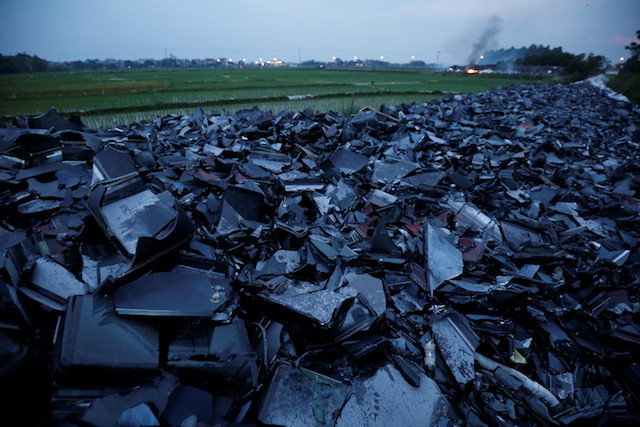E-waste levels surge 20 percent in 5 years: UN
Change Size
 Broken TV and computer screens are seen at a garbage dump near a rice field in Vinh Phuc province, Vietnam, July 1, 2020. Picture taken July 1, 2020.Humans discarded more than 50 million tons of electronic waste last year -- an increase of 20 percent in just five years -- making tech refuse the world's fastest growing waste problem, the United Nations said Thursday. (Reuters/Kham)
Broken TV and computer screens are seen at a garbage dump near a rice field in Vinh Phuc province, Vietnam, July 1, 2020. Picture taken July 1, 2020.Humans discarded more than 50 million tons of electronic waste last year -- an increase of 20 percent in just five years -- making tech refuse the world's fastest growing waste problem, the United Nations said Thursday. (Reuters/Kham)
H
umans discarded more than 50 million tons of electronic waste last year -- an increase of 20 percent in just five years -- making tech refuse the world's fastest growing waste problem, the United Nations said Thursday.
In its annual report on e-waste -- tossed away smartphones, computers, white goods and electronic car parts -- the UN said that materials worth more than $55 billion (50 billion euros) were being wasted every year.
In 2019 only 17 percent of the year's 53 million tons of e-waste was recycled, with the rest ending up in scrapheaps or landfill.
With its unreclaimed deposits of gold, silver, copper and platinum as well as highly-prized rare Earth metals, non-recycled e-waste means more must be mined to equip consumers with new products.
The report's authors blamed ever-shorter device lifespans and a lack of recycling infrastructure for the ballooning e-waste problem.
"E-waste quantities are rising three times faster than the world's population and 13 percent faster than the world's GDP during the last five years," said Antonis Mavropoulos, president of the International Solid Waste Association.
"This sharp rise creates substantial environmental and health pressures and demonstrates the urgency to combine the fourth industrial revolution with circular economy."
According to the report, Asia generated the greatest volume of e-waste in 2019, with 24.9 million tons, followed by the Americas (13.1 Mt) and Europe (12 Mt), while Africa and Oceania generated just 2.9 Mt and 0.7 Mt respectively.
Europe had the highest e-waste figure per capita.
To put the numbers into perspective, 53 million tons is substantially heavier than every adult in Europe put together, or as much as 350 cruise ships the size of the Queen Mary 2.
It equates to more than seven kilograms of e-waste for every human on the planet.
The UN warned that e-waste contained a number of toxic substances known to be harmful to human health.
"Substantially greater efforts are urgently required to ensure smarter and more sustainable global production, consumption, and disposal of electrical and electronic equipment," said David Malone, rector at the United Nations University and UN under secretary general.
"This report contributes mightily to the sense of urgency in turning around this dangerous global pattern."









